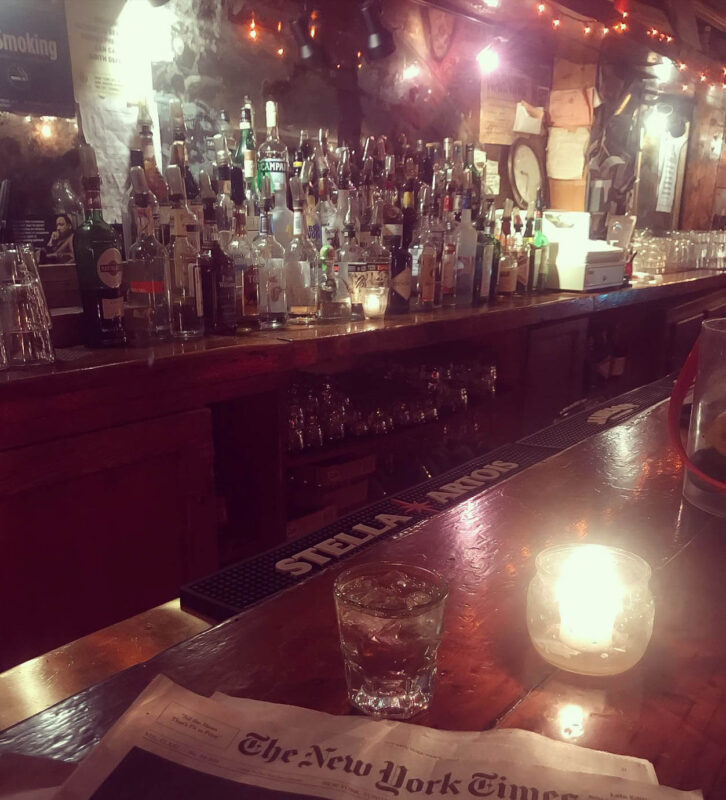
After Hours
Literary Dive Bars
What inspires a NYC writer? Cheap booze, good gossip, sticky floors—and maybe just a bit of gloom.
Beers and shots + a little grotty + a feeling that merely being there might make a little talent rub off on you—the makings of a great literary dive bar.
Tile Bar in the East Village has been open and grimy since 1984.
Rule number one: Don’t ask for a menu of cocktails, the way that older guy in finance just did. And don’t ask for a Negroni, which was his second silly question. This place is all about $5 beers, cash only, no food. It’s where the regular customers are struggling writers with day jobs, where even the bartender is a songwriter and poet.
Two patrons, Tom and Jay, are proofreaders at the SoHo Press, but “dabble in fiction.” The movie Scarface is silently playing on the TV in the corner, next to the classic jukebox; shots and beers are on the bar, customers happily chatting.
When the bar opened it was known as WCOU Radio (there’s a large neon sign with a clock) but the tile on the door frame and the floor inspired people to call it Tile Bar instead. Patrons naming or renaming East Village bars in the 1980s was a bit of a thing, and now this place actually has a nice blue and white awning with the nickname.



Walk around the corner, and join the (also struggling) literary crowd at the very tiny Big Bar.
Why the lurid red lighting? It could be a tribute to the Italian horror director, Dario Argento, whose picture hangs on the wall. Stefan O. Rak, the bar’s owner, is an author, and the Sunday bartender, K. Hank Jost, edits Spark, Sputter and Die, a literary collective.
One of the longtime regulars is Selma Slabiak, whose book, Spirit of the North: Cocktail Recipes and Stories From Scandinavia, leans against the wall at the bar, just next to the Burroughs Portable Adding Machine, the inventor of which is the grandfather of writer William S. Burroughs. The sign on the door reads, “No physical ID, no entry. This is not a new thing.” Another near the restrooms says, “One person per bathroom or you’ll be asked to leave.”
I mentioned that I came in once in 1991, just one year after Big Bar had opened, and saw Jan Hooks (then on SNL) sitting alone and complaining about Lorne Michaels to the bartender. “That’s so cool!” one customer exclaimed. “I can’t wait to tell my girlfriend that! She comes in here alone and works on her screenplay.”
Another literary gathering spot, open since 1993, is the Soviet-themed KGB bar, (named not after the state surveillance agency, but for Kraine Gallery Bar) a tiny place upstairs from the Kraine Theater on East 4th Street.
There are nightly readings by both well-known authors and poets (Jonathan Franzen, Joyce Carol Oates, and David Lehman, to name a few) along with the struggling but worthy. The building was originally the Ukrainian Labor Home, a social club for Ukrainian Socialists. Despite the décor and the name, KGB no longer sells Russian vodka and beers, in favor of Ukrainian products—and much of the Russian-related propaganda on the walls has been replaced by Ukranian images. To an unknowledgeable visitor, it still looks Russian-like, but really Ukrainian. A sign of the times.


The Scratcher, which takes its name from the Irish slang for bed (at a time when mattresses were made from straw and scratchy), is all old wood, twinkly year-round lights, cheap pints of Guinness, and, if you’re lucky, people drunkenly making out in the corner. “It’s been exactly the same since I started going there in 2000,” says critic and actor Christian Lorentzen. “It’s where writers go to swap stories, never to network.” Adds Vanity Fair writer Nate Freeman: Scratchers became a writers’ hangout because “historically, it was close to the old Village Voice and New York Observer offices and Harper’s Magazine. It’s divey but chill. Writers are very particular about the optics of where you have a drink after work. It can’t look like a place that’s trying too hard.”


Parkside Lounge on Houston Street has been a disgusting dive bar since it opened back in 1908, but in more recent years it’s been using its back room for performances and special events. Far less literary than KGB, it has a regular trivia night, and musical acts, but it also has an open mic night for spoken word. Hey, as a struggling writer, you have to start somewhere.
Hero photo of The Scratcher by Natalie Walshe



